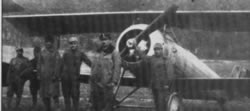|
The ARR during World War Two
|
|
|
|
|
|
|
|
|
|
|
|
|
|
|
ARR history
Early pioneers and flight school
|
A Wright plane at Chitila in front of the nr. 3 hangar
|
The ARR takes shape : from a single airfield to an independent airforce
|
Cotroceni airfield, as it was in 1911. At the left side there is a Farman airplane and at the right a Bleriot
|
At the outbreak of WW1, Romania chose to remain neutral at start, but slowly started to approach the Western powers, as the Austro-Hungarian empire, which occupied the Romanian province of Transilvania was naturally regarded as an enemy. Unfortunately, this also meant that the airforce was all but cut off from its French and British suppliers. Indeed, the airforce had been completely separated from the army on the 15th of August, 1915, when the "Aviation Corps" had been created as a independent branch of the armed forces, but its situation wasn't very good. |
|
|
|
A Caudron G-3 prepares for a reconnaissance mission. Autumn 1916 |
|
|
Two Nieuport BB fighters and a Farman 40 on the Moldavian front. Summer 1917
From late June 1917 to mid August 1917, the 2nd Group flew 467 combat missions, 265 of which were combat patrols performed by fighters, 55 observation sorties, 35 photo reconnaissance, 40 artillery observation, and many others ( including liaison and dropping leaflets or spies behind enemy lines ). The group's tasks had been specified by the Operations order number 1638, which stated : " For as long as the fighting continues, at least 2 reconnaissance aircraft will always be in the air, if the weather allows it, to keep the Corp's commander informed by wireless and written messages with the progress of the battle and with any changes that might occur on the enemy's situation. All the airplanes that can be assigned to artillery observation will also ensure that our artillery fire will be as efficient as possible. The fighter squadrons will protect our airplanes whilst in flight and engage the enemy ones. All remaining aircraft shall be used for long-range reconnaissance behind enemy lines and for bombing raids." |
|
The Aviation Corps served with distinction until the end of the war, which came 1919 for them, because the Romanian army had to engage in a campaign against communist Hungary in early 1919 as well as to face disorganized gangs of Russians threatening its eastern border. 4 more Hungarian planes were shot down during these last battles. |
 |
|||
|
||||